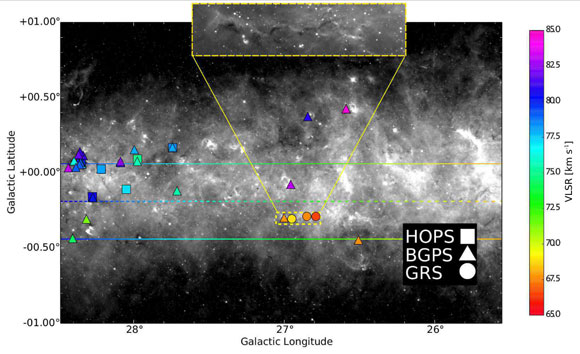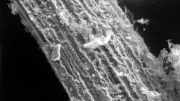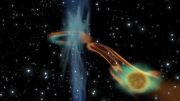
A filamentary dark cloud, a possible “bone in the skeleton of the Milky Way,” as seen in the infrared with the Spitzer Space Telescope’s IRAC camera. This filament stretches over about 45 light-years.
Using infrared surveys from the Spitzer Space Telescope, astronomers have identified ten new filamentary dark clouds in the Milky Way and are looking for more in order to study the “skeletal” makeup of the galaxy.
Our home galaxy, the Milky Way, is a typical barred spiral galaxy, a flattened disk of about a hundred billion stars, gas, and dust that is roughly one hundred thousand light-years in diameter. The galactic disk is surrounded by a large spherical, diffuse halo roughly about five hundred thousand light-years in diameter. Although it is our home, many fundamental questions remain about the Milky Way’s structure. For instance, how many major spiral arms does it have, two or four? What are the precise locations and shapes of these arms? What is the nature of the inter-arm structures —are they well-defined spurs of star and gas or more web-like in form? And not least, does it even make sense to describe the Milky Way as a typical spiral?
One difficulty astronomers encounter in answering these and similar questions is the fact that we are embedded within the very galaxy we are attempting to disentangle. The current understanding of the Milky Way’s three-dimensional structure stems largely from measurements of the velocity of its gas clouds. Like all spirals the Milky Way rotates, and knowing the general plan of rotation enables astronomers to relate the line-of-sight velocities into distances and hence to construct a rough, three-dimensional model (although it is often difficult to disentangle features at different distances but along the same line-of-sight).
CfA astronomers Catherine Zucker, Cara Battersby, and Alyssa Goodman have been trying to trace the “skeletal structure” of the Milky Way as defined by dense, filamentary, and very elongated cold, dark clouds of gas and dust. These structures can stretch over as much as a thousand light-years in length yet are only a few light-years across. The scientists argue that they are part of a kind of spine for the spiral arms in which they reside. The first one was spotted in mid-infrared surveys about five years ago, and the team set out to discover other skeletal features with the aim of using them to help resolve some of the outstanding puzzles of the Milky Ways structure.
The astronomers used infrared surveys to identify ten new, candidate features, all of which lie parallel to and very close to the mid-plane of the Galaxy. Six have aspect ratios of more than about fifty-to-one, and masses of thousands of solar masses (perhaps even up to ten thousand solar masses). Analysis of the results supports the idea that these filaments mark the locations of significant features in the spiral arms. The team hopes to be able to identify hundreds of similar Milky Way “bones,” and to combine these skeletal structures with other tracers of the Galactic framework in order to piece together a much better view of the Milky Way’s architecture.
Reference: “The Skeleton of the Milky Way” by Catherine Zucker, Cara Battersby and Alyssa Goodman, 3 December 2015, The Astrophysical Journal.
DOI: 10.1088/0004-637X/815/1/23
arXiv:1506.08807









Milky way bones and spines of long gas strands forming a skeleton may be due to hairy spread of Dark Matter throughout the galaxy. It could be due to either creation or channelization of the created clouds of light matter by the Dark Energy.. Thank You.